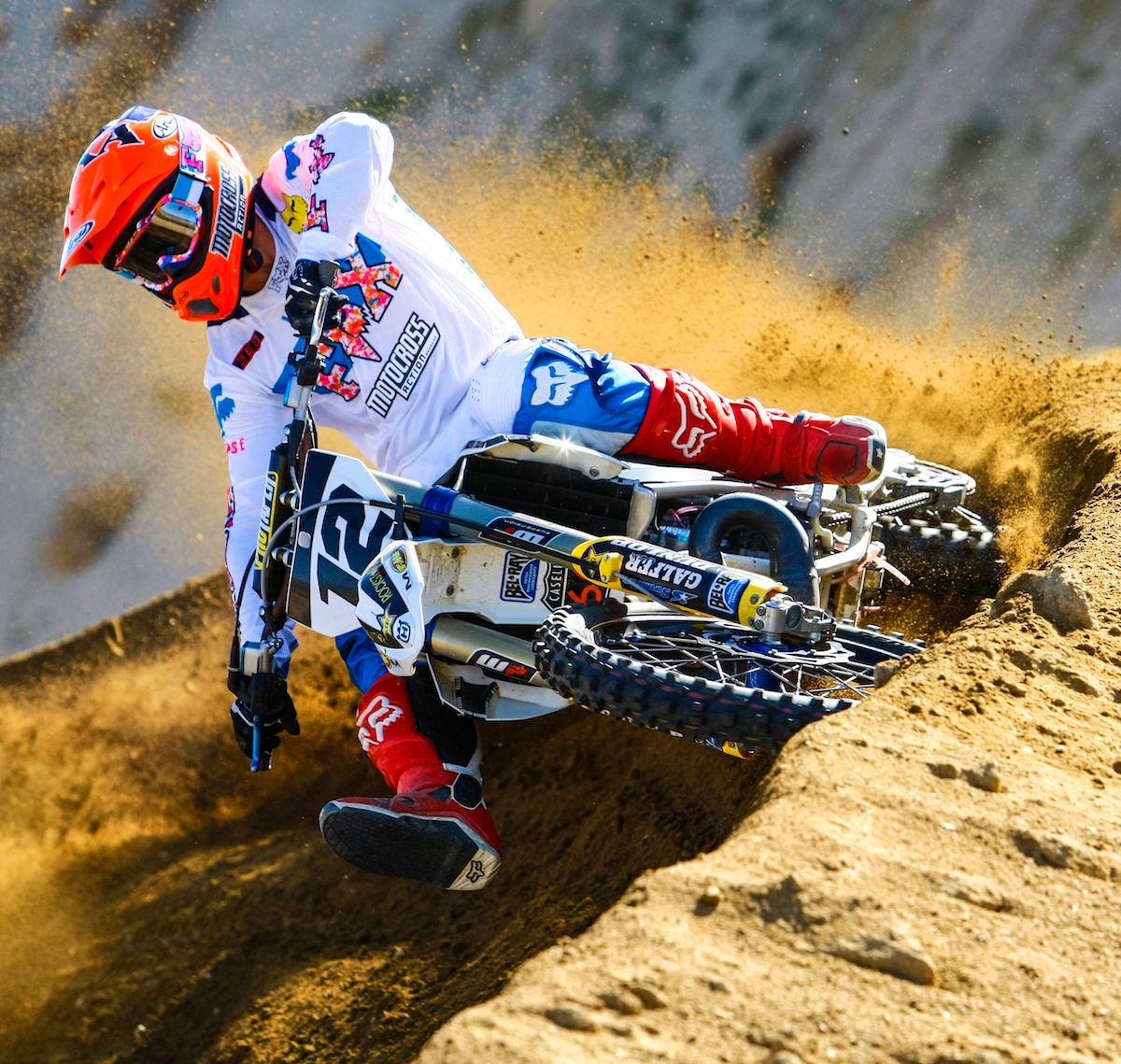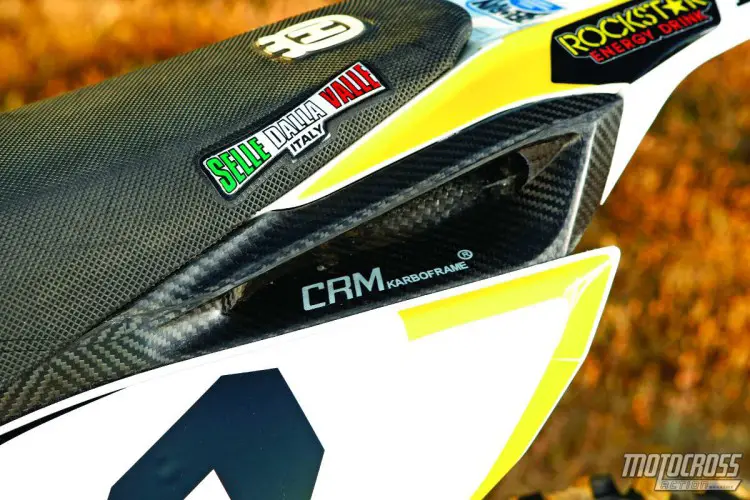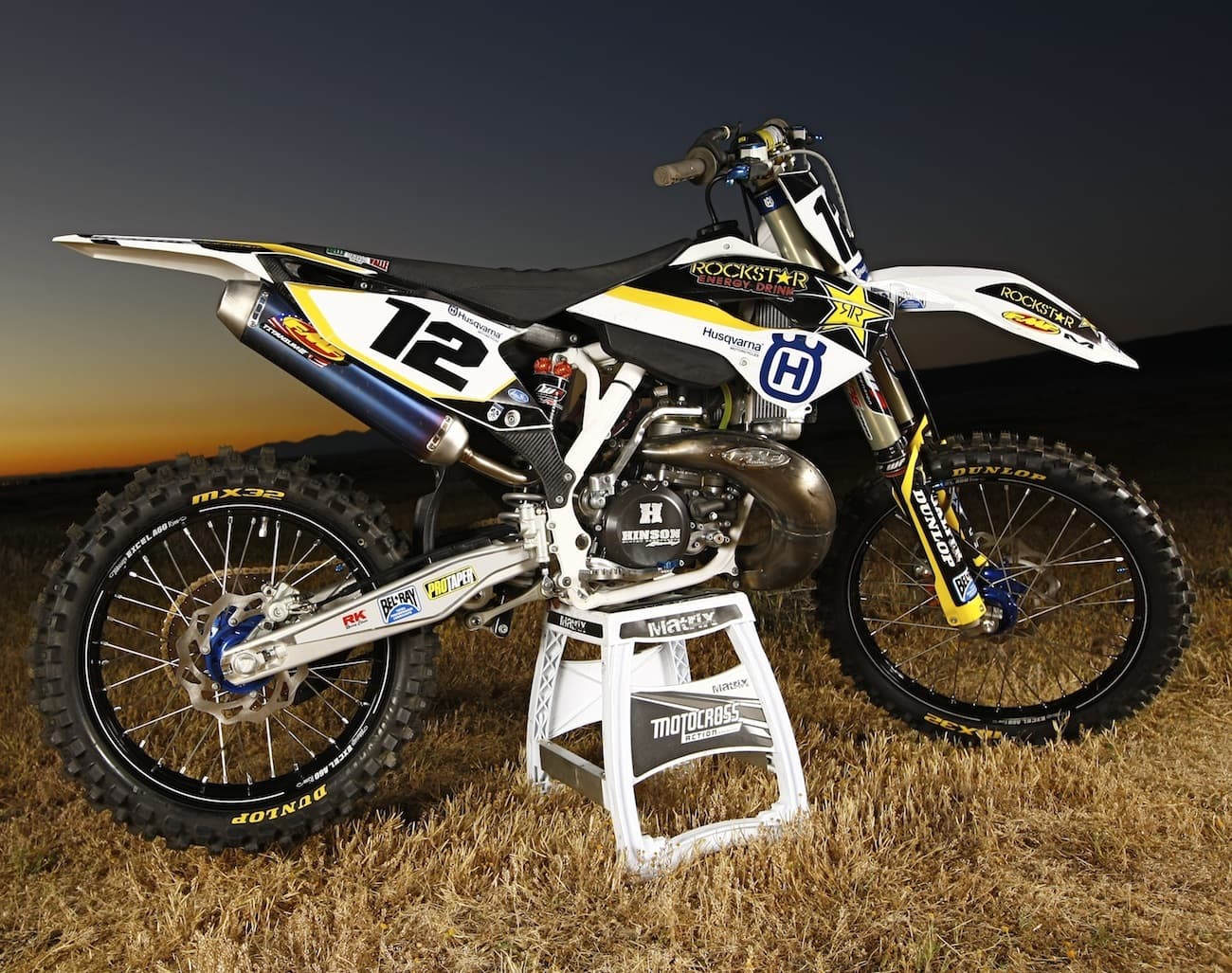MXA TWO-STROKE FILES: DARYL ECKLUND’S HUSQVARNA TC300
By Daryl Ecklund
When opportunity knocks, grab hold and embrace it—these are the words that I live by. And while it might not always turn out pretty, it’s still a thrill. Since I retired from Pro racing in 2008, more of my time is spent as a desk jockey writing stories instead of burning laps. Thinking that his best racing days are behind him is a hard pill for any former Pro to swallow. So, when the opportunity to ride a full-factory smoker at the 2015 MTA-sponsored World Two-Stroke Championships came knocking at my door, I answered.
I had asked for the fastest bike that Husky could build. I have since learned to be careful what I ask for. The Factory Services’ 300cc engine was a fire-breathing monster.
Andy Jefferson, an iconic racer from his day, is now a big-wig at Husqvarna. Andy personally asked me to race a factory-built 2015 Husqvarna TC300 in the race. Husqvarna would take care of the bike, the mechanic, the prep and all the details—all I had to do was show up and ride. Even though I was sick as a dog, who in his right mind would pass up that kind of opportunity? I only had one condition; I wanted the bike to be fast—really fast.
As luck would have it, the first day that Andy scheduled a shake-down test at Glen Helen was the same day the track was closed to prep for one of those faddish mud-run events. To salvage our test, we needed a rough, fast, square-edge track that would mimic the brutal beating of coming down Mt. Saint Helen. That was almost an impossible task, but Andy knew of a secret track just outside of the high desert town of Victorville. I followed the Husqvarna Sprinter van right up to the razor wire of the Victorville Prison. As Husqvarna’s Andy Jefferson, mechanic Charles Jirsa and PG Suspension’s Bart Hayes kept an eye out for the prison guards, I rode on the 40-year-old beater practice track.

I had asked for the fastest bike that Husky could build. I have since learned to be careful what I ask for. The Factory Services’ 300cc engine was a fire-breathing monster. It had a 250 bottom end mated to a 300cc barrel with Factory Services’ special touches. In my mind, it was exactly what I had wished for, but I had no clue that a full-race 300cc two-stroke could hit so hard. It was obvious that I’d be able to pull the holeshot into Glen Helen’s Talladega first corner, but I wasn’t sure if I would be able to hang on to that thing for 30 minutes. So, for the first time in my 29 years, I timidly asked Andy if we could slow it down a bit. He grinned. We changed gearing, tried different exhaust systems and swapped out the power-valve springs. As the afternoon sun set over the mountains, the Husqvarna TC300 was still a handful.
As the race got closer, I got sicker. I developed the flu and whooping cough. The severity of the cough was so bad that I ruptured an eardrum.
A few days later, I took the Husky to my local stomping ground at LACR. I was blowing by 450s up the hill like they were standing still, but I just wasn’t in racing shape. I had gotten what I asked for, but how was I going to reverse direction and ask Husky for something a lot slower? Twenty minutes later, my prayers were answered when my super-exotic Husky TC300 gave up the ghost. I didn’t care if it was a fouled plug, lack of fuel or a seized ring, because this was my opportunity to persuade Andy to ignore what I said last week and replace the Ferrari engine with something more manageable, like a stock 250 jug.

Daryl tried many different FMF pipes to fine-tune the power delivery. He opted for the pipe that made the TC250 easiest to ride.
Here is what was done to my 2015 Husqvarna TC250.
(1) Engine. As the race got closer, I got sicker. I developed the flu and whooping cough. The severity of the cough was so bad that I ruptured an eardrum, got an ear infection and actually had blood coming out of my ear. I mention this as an excuse for why I got passed by 52-year-old Doug Dubach (in not one but both motos). As sick as I was, I still didn’t want to give up my Husqvarna factory ride to the MXA test riders who were lining up for a shot. I loved how well the newly installed 250cc engine pulled. The power suited me better than the 300. It had more bottom, a smoother midrange and added overrev. It made the bike more friendly to ride and lessened the number of shift points. Both of my starts were inside the top five in a lineup against 500s and 300s. Internally, the engine was stock, but Charles Jirsa had employed his secret jetting and a different slide, and VP MRX02 gas was running through its veins.
 The big-bore 300 that Factory Services made for Daryl was too fast for mere mortals. Husky switched out the engine for a 250 to make it more manageable.
The big-bore 300 that Factory Services made for Daryl was too fast for mere mortals. Husky switched out the engine for a 250 to make it more manageable.
(2) Suspension. It took some persuading, but Husky got WP’s Kyle Guglielmetti to mount top-of-the-line WP cone-valve forks, along with the WP Trax shock, on my race bike. WP sent it off to one of their WP authorized dealers, PG Suspension, to have it valved. They valved the components to my weight and skill level. The owner of the company, Bart Hayes, came out from North Carolina to tune the WP suspension for me. On the first lap at the prison test track, I was all over the place. The settings felt very far off from where they needed to be. Bart informed me the Trax shock and cone-valve forks had a much wider range of adjustment than the stock setup. He was right. Just one or two clicks made a major difference. The Trax system was hard to get used to. When the shock feels the pressure on the rear-wheel decrease, it activates a mechanism that pushes the rear end toward the ground. It had a notchy feel to it, but did deliver increased traction to the ground. The cone-valve forks had some stiction through the stroke compared to the A-Kit forks, but they had a more fluid motion than the standard WP 4CS forks. It was nice to work with someone as experienced as Bart. He was very good at turning my feedback into results with his adjustments.
 The WP cone-valve forks are an expensive upgrade from the harsh WP 4CS forks, but they are worth their weight in gold. They are plush on top and firm at the bottom.
The WP cone-valve forks are an expensive upgrade from the harsh WP 4CS forks, but they are worth their weight in gold. They are plush on top and firm at the bottom.
Since we never got to test at Glen Helen, race day was a guessing game for Andy, Charles and myself. The track was getting rougher with each passing hour, and I was already using most of the stroke. The TC250 was perfectly balanced, so it was just a question of how stiff to go. Halfway into my motos the suspension was perfect, but it started to bottom toward the end. It was hard to find a happy medium as fatigue set in. As with most factory suspension, it worked great when I was fresh, but not as well once I started to make mistakes. The best thing about the cone-valve forks was that they didn’t have a harsh metal-to-metal feel when they bottomed. They were very forgiving. However, I did throw up at the end of moto one (how embarrassing).
Don’t cry for me. My bruised ego will heal—and then I have a score to settle with that TC300 engine.
(3) Exhaust. From the photos, you might be thinking that the FMF silencer looks more like the big four-stroke muffler. Yes, it is about double the length of the FMF Shorty silencer, but the longer silencer produced more top-end power. FMF also produces a much lower decibel number with the added length.
(4) Subframe. The Husqvarna Supercross team can’t run a carbon fiber subframe because AMA rules state that the only material that can be used on a subframe is the stock material, aluminum or titanium. I, however, could run a carbon fiber subframe. The carbon component is more rigid than the plastic OEM subframe, which is why Husqvarna’s offroad team chooses to run the stocker, even though they can use carbon fiber. Additionally, Husqvarna’s Jason Anderson removes one bolt from each side of his lower subframe brackets to allow for more flex from the rear of the bike. The big plus of the carbon fiber design is that it allows more air to flow into the engine.
 The super-trick carbon fiber subframe is a work of art. It is very light and allows more air into the airbox for better power and throttle response.
The super-trick carbon fiber subframe is a work of art. It is very light and allows more air into the airbox for better power and throttle response.
(5) Front brake. I love the stopping power of the stock OEM Brembo brakes. Andy Jefferson replaced the tried-and-true Brembo caliber with a Factory Brembo assembly. More stopping power? Not really. It felt less powerful, but the lever had a more progressive feel. It had plenty of stopping power but had the ability to be metered to the nth degree.
(6) Final words. My ego was crushed by four things: First, when the Doctor blew by me. Second, when I had to confess to Andy that he had built a bike that was too fast for my ability. Third, watching Mike Sleeter not even break a sweat on his way to winning the World Two-Stroke Championship on a KTM 300SX. Fourth, blowing chunks after moto one. Don’t cry for me. My bruised ego will heal—and then I have a score to settle with that TC300 engine.










Comments are closed.